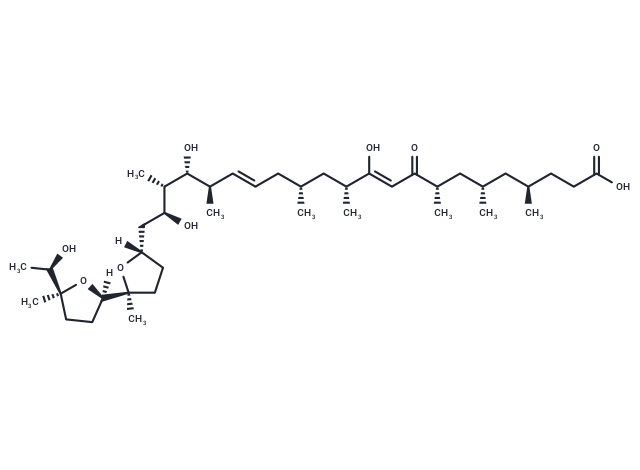Shopping Cart
Remove All Your shopping cart is currently empty
Your shopping cart is currently empty
Ionomycin is a calcium ion carrier and an antibiotic that binds to calcium ions (Ca2+). The main function of Ionomycin is to induce cellular responses by increasing the intracellular calcium ion concentration. In experiments, Ionomycin is typically used to activate calcium-dependent processes, such as apoptosis and enzyme activity.

| Pack Size | Price | USA Warehouse | Global Warehouse | Quantity |
|---|---|---|---|---|
| 1 mg | $196 | In Stock | In Stock |
| Description | Ionomycin is a calcium ion carrier and an antibiotic that binds to calcium ions (Ca2+). The main function of Ionomycin is to induce cellular responses by increasing the intracellular calcium ion concentration. In experiments, Ionomycin is typically used to activate calcium-dependent processes, such as apoptosis and enzyme activity. |
| In vitro | METHODS: LCLC 103H cells were treated with Ionomycin and analyzed using DNA and protein. RESULTS: Ionomycin induces DNA fragmentation and PARP lysis into an 85-kDa fragment of typical caspase-mediated apoptosis. [1] |
| In vivo | METHODS: To investigate the activation of immune cells by Ionomycin, PMA and Ionomycin were used to activate CD4+CD25- T cells in mice to generate inductive regulatory T cells (iTreg), and their functions were tested in a mouse model of inflammatory bowel disease (IBD). RESULTS: iTreg cells activated by Ionomycin could significantly alleviate the symptoms of IBD mouse models, including weight loss and reduced disease activity scores. [2] METHODS: To study the role of calcium signaling in embryonic development, Ionomycin was added to the mouse embryo culture medium. RESULTS: Calcium signaling plays a key role in embryonic cell migration and morphogenesis. [3] |
| Molecular Weight | 709.01 |
| Formula | C41H72O9 |
| Cas No. | 56092-81-0 |
| Smiles | [H][C@@]1(C[C@H](O)[C@H](C)[C@H](O)[C@H](C)\C=C\C[C@@H](C)C[C@@H](C)C(\O)=C\C(=O)[C@@H](C)C[C@@H](C)C[C@H](C)CCC(O)=O)CC[C@](C)(O1)[C@@]1([H])CC[C@](C)(O1)[C@@H](C)O |
| Relative Density. | 1.072 g/cm3 |
| Color | White |
| Appearance | Solid |
| Storage | store at low temperature,keep away from direct sunlight | Powder: -20°C for 3 years | In solvent: -80°C for 1 year | Shipping with blue ice/Shipping at ambient temperature. | |||||||||||||||||||||||||||||||||||
| Solubility Information | Ethanol: 90 mg/mL (126.94 mM), Sonication is recommended. DMSO: 90 mg/mL (126.94 mM), Sonication is recommended. | |||||||||||||||||||||||||||||||||||
| In Vivo Formulation | 10% DMSO+40% PEG300+5% Tween 80+45% Saline: 3.3 mg/mL (4.65 mM), Sonication is recommended. Please add the solvents sequentially, clarifying the solution as much as possible before adding the next one. Dissolve by heating and/or sonication if necessary. Working solution is recommended to be prepared and used immediately. The formulation provided above is for reference purposes only. In vivo formulations may vary and should be modified based on specific experimental conditions. | |||||||||||||||||||||||||||||||||||
Solution Preparation Table | ||||||||||||||||||||||||||||||||||||
Ethanol/DMSO
| ||||||||||||||||||||||||||||||||||||
| Size | Quantity | Unit Price | Amount | Operation |
|---|

Copyright © 2015-2025 TargetMol Chemicals Inc. All Rights Reserved.